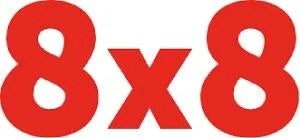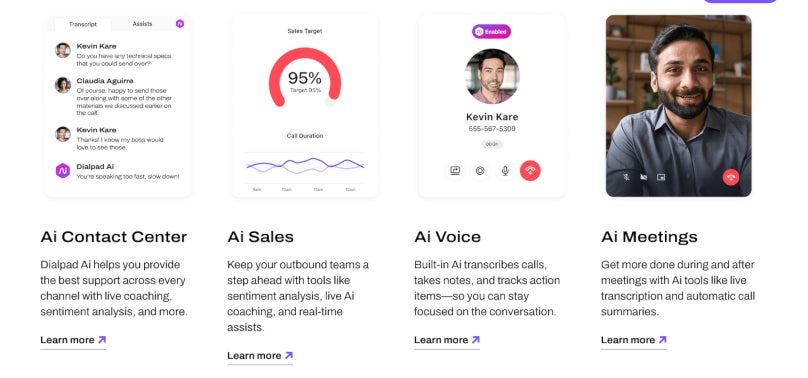- Best UCaaS provider overall: Nextiva
- Best price for less than five users: RingCentral
- Best for easy DIY setup: Ooma
- Best for videoconferencing: Zoom
- Best for international calls: 8×8
- Best for AI-powered communication: Dialpad
I’ve had an eye on the business communication space for years, watching solutions change as new tech emerges while others quietly disappear in mergers and acquisitions. Whether you’re a small business looking for your first phone system or an enterprise looking for the best UCaaS provider overall, this guide will help you find the right fit for your team.
Top UCaaS providers comparison
Each UCaaS platform has unique strengths that set it apart. Here’s a quick overview of the best UCaaS solutions on the market.
| Nextiva | |||||
| RingCentral | |||||
| Ooma | |||||
| Zoom | |||||
| 8×8 | |||||
| Dialpad |
Nextiva: Best UCaaS provider overall
Nextiva stands out by offering a full suite of UCaaS tools, covering more channels than most even on its cheapest plan. From small startups to large enterprises, it integrates voice, video, team collaboration, social media, live chat, and text messaging capabilities into a single cohesive ecosystem.
Why I chose Nextiva
It’s a great option for companies looking to simplify their communication methods while also improving operational efficiency and boosting customer satisfaction.
One of the most compelling aspects of Nextiva is its reliability. With a 99.999% uptime guarantee, its users rest easy knowing the system’s always up and running.
Nextiva also provides responsive, 24/7 support, ensuring that any customer issues are swiftly addressed while minimizing service interruptions. In my experience, it has some of the best customer service I’ve seen.
Read my review of Nextiva for more details.
Pricing
- Digital: Starts at $20 per user per month.
- Core: Starts at $30 per user per month.
- Engage: Starts at $40 per user per month.
- Power Suite: Starts at $60 per user per month.
- Essential: Starts at $129 per user per month.
- Professional: Starts at $159 per user per month.
- Premium: Starts at $199 per user per month.
Essential, Professional, and Premium are considered enterprise plans for omnichannel contact centers needing tools to manage high call volumes and large workforces.
Features
- Unlimited voice calling in the U.S. and Canada.
- Top-tier 24/7 customer and technical support.
- Live chat, messaging, texting, email, social, faxing, and video in one.
- Simple interactive voice response capabilities across the board, perfect for small teams.
- Centralized inbox to easily manage communications.
- GDPR and PCI DSS compliant.
- Full suite of dashboards and reporting tools.
- Chabots, intelligent routing, and more on higher tiers.

Pros and cons
|
|
RingCentral: Best price for less than five users

Don’t let RingCentral’s entry-level price point of $9.99 per user per month for up to five users fool you — it comes with a wide range of interesting features and more advanced capabilities than UCaaS platforms that cost three times as much.
Plus, you’ll get voice, video, team chat, SMS, and file sharing no matter the plan you choose.
Why I chose RingCentral
RingCentral’s recent price drop for small teams makes it one of the most affordable UCaaS solutions on the market, despite the staggering number of features it comes with.
Even if you have more than five users, the platform’s still a great value for the money.
It’s incredibly versatile and able to adapt to your needs, whether you’re a small team looking for basic communications or a large organization needing advanced collaboration and customer experience tools.
Another key benefit is its extensive list of integrations, allowing you to automate workflows and sync data across more than 300 third-party applications and services.
Read my RingCentral review for more details.
Pricing
- Core (1-5 users): Starts at $9.99 per user per month.
- Core (5-100 users): Starts at $20 per user per month.
- Advanced (1-100 users): Starts at $25 per user per month.
- Ultra (1-100 users): Starts at $35 per user per month.
Once you surpass 100 users, you’ll qualify for custom pricing with high volume discounts.
Features
- Free local or toll-free numbers.
- 100, 1,000, or 10,000 free toll-free minutes.
- Unlimited domestic calling in the US and Canada.
- Strong IVR capabilities on all plans.
- AI-powered noise cancellation.
- On-demand and automatic call recording.
- Up to 8-digit extensions on some plans.
- Unique push-to-talk add-on.

Pros and cons
|
|
Ooma: Best for easy DIY setup

Although Ooma’s entry-level plan only includes voice and fax, its higher tiers include UCaaS features, like texting, team chat, and videoconferencing capabilities. It’s a strong choice for in-person office environments that also need digital collaboration tools.
Why I chose Ooma
Technically, any of the providers on this page are easy to implement if your system is small and your needs are basic.
However, Ooma’s one of the few that truly foolproofs the process of setting up desk phones. On top of that, the system itself is about as simple as it can get. If you’re a fan of straightforward, barebones software, you’ll appreciate its simplicity compared to other solutions.
It also comes with features specifically for traditional offices, like overhead paging and intercom which you won’t find elsewhere.
Read my Ooma review for more details.
Pricing
- Essentials: Starts at $19.95 per user per month.
- Pro: Starts at $24.95 per user per month.
- Pro Plus: Starts at $29.95 per month.
Ooma is one of the few providers that doesn’t make you sign a year-long contract to get the best rates, making it a great choice for businesses with seasonal or temporary needs.
Features
- Basic virtual receptionist to greet callers.
- Complete company directory built in.
- Unlimited virtual faxing on every plan.
- Extension dialing and monitoring.
- Music on hold or transfers.
- Enhanced call blocking capabilities.
- Overhead paging and intercom.
- Call recording, queues, and hot desking on higher tiers.

Pros and cons
|
|
Zoom: Best for videoconferencing

Zoom is well known for its videoconferencing capabilities and user-friendly interface. However, it also offers a range of phone plans and UCaaS solutions for businesses that need high-quality video meetings, team chat, text messaging, and crystal clear audio.
Why I chose Zoom
From white boards and digital backgrounds to document creation, waiting rooms, and an AI companion, it’s hard to beat Zoom’s videoconferencing platform. If you’re already using it for that, upgrading to a Workplace + Phone plan won’t cause disruptions for your team.
It’s also a great choice if you rely heavily on video meetings and need to supplement that communication channel with a straightforward phone system.
You’ll even get a range of basic call center tools, like IVR, automatic call distribution (ACD), and live call monitoring capabilities to improve the inbound call experience.
Pricing
Zoom has phone-only plans that start at $10 per user per month. However, these don’t include internal collaboration tools.
For UCaaS features, you’ll need to go with one of two Zoom Workplace + Phone plans:
- Pro Plus: Starts at $18.33 per user per month.
- Business Plus: Starts at $22.50 per user per month.
Both include the same phone features, but the Business Plus plan includes additional features, like visitor management, translated captions, workspace reservations, customer support via phone, and larger meeting capacity.
Features
- Unlimited calling in your region.
- Active noise, echo, and keyboard sound suppression.
- Automatic call distribution and queueing.
- Manual and automatic call recording on every plan.
- Easy call handoff between devices.
- Hot desking for in-person offices.
- Elevate calls to a video meeting.
- Zero-touch device provisioning.
- Mix and match plans as needed.

Pros and cons
|
|
8×8: Best for international calls

8×8 is an established business communications provider with decades of experience. Over the years, it has added a comprehensive suite of collaboration tools, analytics, and basic AI-powered features on top of a secure and compliant platform.
Why I chose 8×8
If you make a lot of international calls or have team members in other countries, 8×8 is a great way to save money. Since it includes unlimited international calling to 14 countries in its cheapest plan and 48 in its next tier, you’ll no longer have to pay international usage fees for those locations.
Other providers don’t offer unlimited calling options or charge extra for them, making 8×8’s inclusive plans a more affordable alternative.
Plus, it offers numerous call and contact center plans, giving you plenty of room to grow.
Read my 8×8 review for more details.
Pricing
8×8 doesn’t publicly disclose pricing. However, there are five plans to choose from:
- X2: Standard UCaaS capabilities.
- X4: Special tools for receptionists and supervisors.
- X6: Voice-only call center software.
- X7: Omnichannel contact center solution.
- X8: Tools for large contact centers.
X2 is the best place to start for standard business communication. If you end up needing more, you can upgrade select users to higher tiers as needed.
Features
- Unmetered calling to 14 or 48 countries.
- HD video and audio meetings with up to 500 people.
- Specialized Frontdesk feature for receptionists.
- Whisper, barge, and takeover for live calls.
- Single sign on with every plan.
- GDPR, HIPAA, and ISO27001 ready.
- Multi-level auto attendant and hot desking.
- Livestream video calls on YouTube.

Pros and cons
|
|
Dialpad: Best for AI-powered communication

As a newer provider in the business communications space, Dialpad started out as a cloud-based solution. As such, it doesn’t have the same technical debt many of the others deal with every day. With a clutter-free interface designed for use on smartphones and laptops, you’ll appreciate its ease of use and powerful AI capabilities.
Why I chose Dialpad
Dialpad offers several AI tools I haven’t seen with other UCaaS providers.
While most of the advanced capabilities are only on call center and sales plans, regular business users can still enjoy real-time call and video transcriptions, call summaries, action item tracking, voicemail transcriptions, and automated insights.
It also offers a wide range of integrations on top of a stable and reliable collaboration suite that covers texting, team chat, video, and faxing if you need it.
Read my review of Dialpad for more details.
Pricing
Dialpad offers a range of business communications, videoconferencing, contact center, and sales solutions. It’s UCaaS plans include:
- Standard: Starts at $15 per user per month.
- Pro: Starts at $25 per user per month (three-user minimum).
- Enterprise: Custom pricing (100-user minimum).
You can try Standard or Pro free for 14 days.
Faxing starts at $10 per number per month, additional numbers are $5 each per month, and a conference room line starts at $15 per number per month.
If you end up needing more, you can upgrade users to Dialpad’s contact center or sales enablement platforms.
Features
- One free number per user.
- AI-powered real-time call transcriptions.
- Automated summaries and action item tracking.
- Integrated voice, video, text, and messaging platform.
- Multi-level auto attendants on every plan.
- Call recording, routing, and spam detection.
- Ability to swap devices during a call.
- HIPAA compliant once a BAA is signed.

Pros and cons
|
|
How do I choose the best UCaaS provider for my business?
The best place to start is assessing your current communication tools and processes. Along the way, you’ll be able to identify gaps or pain points, like poor call quality, high operational costs, or inadequate security features. From there, you can look for a UCaaS solution that addresses these issues and offers scalability for future growth.
After you’ve shortlisted a handful of providers, check reviews to evaluate reliability, customer support, and integration capabilities with your existing tools.
A free trial can also be invaluable for testing usability and ensuring the platform meets your expectations.
Beyond that, a personalized demo can give you a good idea of what the solution looks like in action while allowing you to ask as many questions as you need to determine if it’s the right fit.
Methodology
I relied heavily on my personal experience in the business communications category as well as a high volume of publicly available reviews, case studies, and additional online resources to back up my own experiences.
My goal was to gather relevant information on real-world performance, customer satisfaction, and overall quality of each provider.
Here’s a closer look at what I considered when putting this guide together.
Features, functionality, and capabilities
The range and quality of features provided by each UCaaS solution played a crucial role — I specifically sought providers that offer complete sets of tools to meet a wide range of communication needs.
Ease and depth of integration
I carefully considered the quality, depth, and execution of each provider’s integrations with other business tools. Simply having a large list of integrations isn’t enough.
Strong connections with CRM, ERP, and collaboration tools were the bare minimum for inclusion in this post.
Pricing structure
To include a range of tools for different business sizes, I specifically chose platforms that span the spectrum in terms of price.
System reliability
Dependable service with minimal downtime is huge for any business. I favored providers with a strong track record of reliability and uptime.
Security and compliance
The best UCaaS provider gives you peace of mind. As such, I prioritized providers that demonstrate a strong commitment to security and compliance with regulatory standards.
Customer support
Access to responsive and helpful customer support was a minimum requirement for inclusion on my list, as it’s vital for businesses to be able to get assistance when they need it.
Source link
lol

